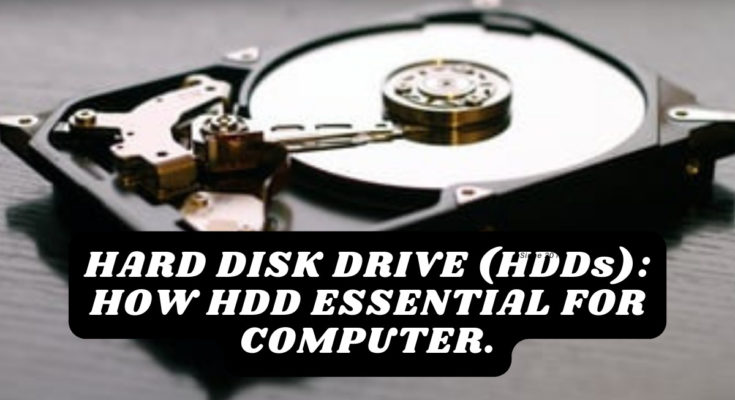HARD DISK DRIVE
A hard disk drive (HDD) is a type of computer storage device that uses magnetic storage to store and retrieve digital information. It consists of one or more rotating disks or platters, which are coated with a magnetic material that can be magnetized to represent binary data (0’s and 1’s).
The platters are read and written to by a magnetic head that floats just above the surface of the disk on a thin layer of air. The head is mounted on an actuator arm that moves it across the surface of the disk to access different areas of data.
HDDs are typically used for long-term storage of large amounts of data in desktop computers, laptops, servers, and other electronic devices. They are relatively inexpensive and offer high capacity, but are slower than solid-state drives (SSDs) in terms of access times and data transfer rates.
To improve performance, HDDs may use a caching system to store frequently accessed data in a faster section of memory, or they may use multiple disks in a RAID configuration for increased speed and redundancy.
HDD ESSENTIAL FOR COMPUTER
An HDD is not essential for a computer to function, but it is a very important component for storing and accessing data. While a computer can technically operate without an HDD, it would be severely limited in its ability to store and retrieve data, and would likely require other forms of storage such as flash drives or external hard drives.
Most desktops and laptops come with an HDD or an SSD as the primary storage device, and the choice between the two depends on the user’s needs and budget. HDDs are typically less expensive and offer higher storage capacity, but they are slower than SSDs. SSDs, on the other hand, are faster and more durable, but they are more expensive and offer less storage capacity.
In summary, while an HDD is not absolutely necessary for a computer to function, it is an essential component for storing and accessing data, and is typically included in most desktop and laptop configurations.
TYPES
There are several types of hard disk drives (HDDs), each with different characteristics and intended uses. Here are some of the most common types:
1. SATA HDD: This is the most common type of HDD and is used in desktop and laptop computers. It connects to the computer’s motherboard using a SATA interface and is available in various capacities ranging from a few hundred gigabytes to several terabytes.
2. SAS HDD: Serial Attached SCSI (SAS) is a high-performance interface used in enterprise-level servers and storage systems. SAS HDDs are faster and more reliable than SATA HDDs, and are often used in data centers and other demanding environments.
3. USB HDD: External hard drives that connect to a computer via USB are also a type of HDD. These are popular for backup and data storage purposes, and are available in various capacities and sizes.
4. SSHD: A solid-state hybrid drive (SSHD) combines the capacity of an HDD with the speed of an SSD. It uses a small amount of flash memory as a cache to store frequently accessed data, while the rest of the data is stored on the HDD. SSHDs are faster than traditional HDDs, but not as fast as pure SSDs.
5. NAS HDD: Network-attached storage (NAS) HDDs are designed for use in network-attached storage devices. These drives are optimized for 24/7 operation and are often used in homes and small offices for data storage and sharing.
6. Surveillance HDD: These are HDDs designed for use in surveillance systems, such as security cameras. They are optimized for continuous recording and can withstand the high temperatures and vibrations associated with surveillance equipment.
These are just a few of the many types of HDDs available on the market, each with different features and capabilities to suit a variety of needs.



